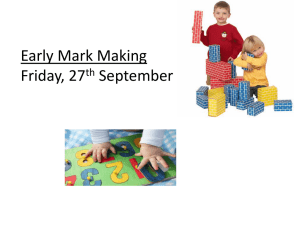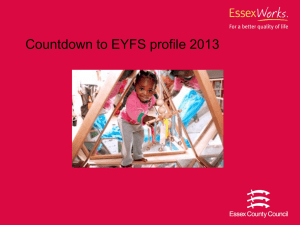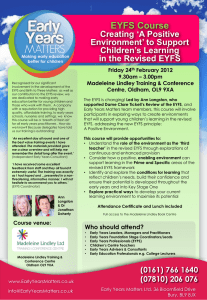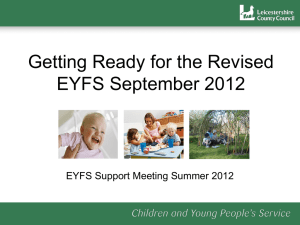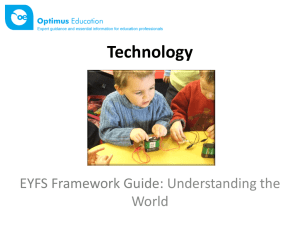Session 1 - TrustNet - Hackney Learning Trust
advertisement
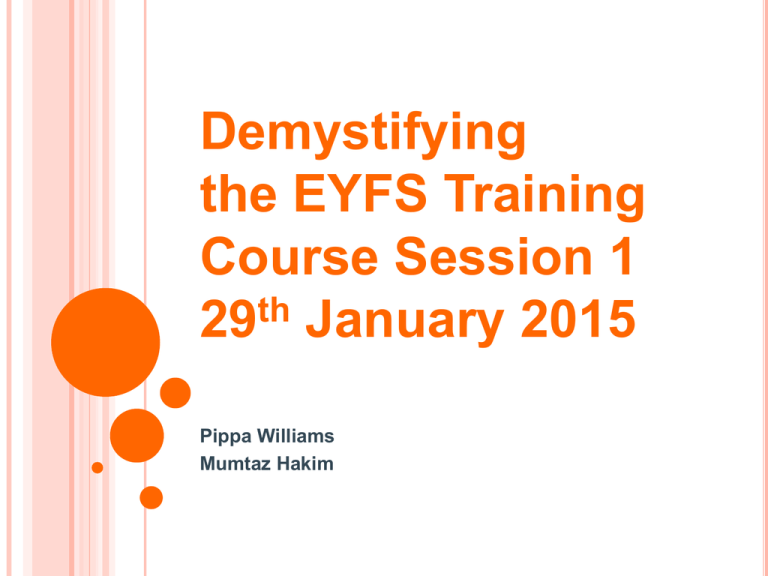
Demystifying the EYFS Training Course Session 1 th 29 January 2015 Pippa Williams Mumtaz Hakim Introductions Health and Safety of the building Breaks Talk to the person opposite to you…… • A childhood memory that you could use in your child care practice • Your childcare experience • One thing that you would like to get out of this course Feedback You will need to complete 2 courses to become a registered childminder Book on E-Learning course “Award in Preparing to work in Home Based Childcare” 10 day CLASSROOM BASED COURSE EYFS Pre Registration Course What happens next • Book onto a Preparing to work in Home Based Childcare on line course and provide evidence of booking by 5.2.2015 Step 1 session. • Complete Hackney Learning Trust’s Childminder’s EYFS Pre –Registration Course Dates: 29.1.2015, 5.2.2015, 12.2.2015, 26.2.2015, 4.3.2015, 19.3.2015, 2.4.2015 EYFS Pre Registration 9.30 to 3pm Linden Children Centre • Introduction to Safeguarding Course 26.3.2015 9.30 to 4.30pm Linden Children Centre Step 2 • First Aid Course = 14.3.2015, 21.3.2015 charge of £90 for this course, PLEASE BOOK ON FEE PAYING COURSE BOOKING FORM-with signature, you will be invoiced after attending the course. •DBS (old CRB checks) there is now a CHARGE of £50 for each DBS check are carried out on yourself, and all those over 16 yrs , a range of other checks are also carried out. Step 3 • Ofsted will be carry out, a range of checks, Health checks are carried out on yourself(there will likely be charge from your GP for this £50-£100) see overleaf ………. WHILST COMPLETING THE TRAINING YOU WILL NEED TO… https://www.gov.uk/register-childminder-childcare-provider/how-to-apply Apply for a Disclosure and Barring Service (DBS) check through the Ofsted portal. •Join the DBS update service and agree to Ofsted checking your DBS certificate at least every 6 months. If you haven’t joined the service 19 days after getting your first certificate, you must get a new one. •Fill in and submit a health declaration booklet if you’re applying as a childminder on the Early Years Register, working directly with children, or a manager in charge of the day-to-day running of childcare on domestic premises. What happens next Step 4 Step 5 Step 6 •On completion EYFS course and confirmation of results of Preparing to work in a Home Based child care and when your DBS checks are back and health checks are back you will need to contact Hackney Learning Trust childminding team who will arrange to visit from yur Co-ordinator who will check you are ready and support you in making your OFSTED Application •Prepare home & paperwork and submit Ofsted on line Application •Apply online - you’ll need a Government Gateway account to log in. If you’re applying to both registers apply using the Early Years application form. •Application process commences with an Ofsted-Inspector who will carry out a registration visit to your home to assess your suitability to implement the EYFS. They will interview you to assess your suitability. You will need to demonstrate to them that you can meet all the requirements of EYFS.-Pre- Reg Form (this form will be used whilst completing the EYFS Pre Reg course) •OFSTED WILL NOT REGISTER ANYONE UNLESS Pre Registration EYFS Course. •You will need to demonstrate that the training that you have undertaken has prepared you for childminding and meeting the requirements. •Ofsted will finally make a decision to either register or refuse your application. Pre registration expectations Provide evidence by SESSION 5.2.2015 of booking on the HBCA Provide evidence of your space in accordance with EYFS requirements Please bring along the following documents to ALL sessions. 1. EYFS Statutory framework 2014 2. Early Years Outcomes 3. The EYFS Progress Check at age two 4. Development Matters 2012 5 Requirements for the Childcare Register: childminders and home childcarers A childcare factsheet You will need to download these from: http://www.foundationyears.org.uk/eyfs-2014/ Or but them for £9.95 from 4Children http://www.4children.org.uk/Resources/Detail/Full-Resource-Pack-StatutoryFramework-for-the-EYFS-2012 Childminders will be required to complete weekly homework which will be collated as your Portfolio of Evidence that will support your registration and quality childminding –this will be looked at during the training and when you collect application form You will need to bring to each session your ring binder folder with plastic sheets for your work Each session will start promptly at 9.30 am and finish at 3pm Course Materials can be found on the child-minder website http://trustnet.learningtrust.co.uk/childminders Course Outline Session 1 Introduction To EYFS/ Health and Safety Session 2 Health and Safety Session 3 CLL and PD -Learning And Development Session 4 PSED- Learning And Development Session 5 Observation, Assessment- Specific Areas of Learning -Learning And Development Session 6 Inclusion QA Session 7 Partnerships, Transitions QA Accept Differences Everyone Participates-Quality Practice discussions Respect Diversity Mobile Phones Off and not used Constructive Criticism Willingness to Make Mistakes Confidentiality Punctuality Self-care Session Aims To begin the process of becoming familiar with the structure and elements of the EYFS To know how to establish a safe and healthy child care environment in a home based setting To familiarise with the Hackney Childminder Website and other useful websites in order to support my practice What’s in the EYFS? • • • • Statutory framework for EYFS What you have to do by law Early Years Outcomes Non statutory guidance for practitioners The EYFS Progress check at age two A know How Guide Development Matters in the EYFS The non statutory guidance material support practitioners in implementing eyfs Key messages of EYFS • • Quality and consistency in all early years settings A secure foundation through learning and development opportunities which are planned around the needs and interests if each individual child and assessed and reviewed regularly • Partnership working –between practitioners and with parents and/or carers • Equality of opportunity and anti discriminatory practice, ensure every child in included and supported EYFS Space Requirements You will need to calculated the numbers of children you can care for using the EYFS Space requirements which are set out in Page 27 paragraph 3.57 (please note this does not include kitchen, storage, thorough fares). To calculate the numbers of children use the following guide and example. Playroom clear space available—2.5mtrs x 2.5mtrs=6.25 square metres divide by 2.5 = 2 x(2 yr olds) The maximum number of children will be 2 -2yr olds in this space You will need to include your own children under 8 yrs in the space. If you care for any children aged eight and over this may affect the number of children you can care for under eight. Preparing for your ideal environment If you had an ideal setting what would it look like? Eg……. Play areas, toys, resources, safety, outdoors, sleep, meal times, toilet, (think about positive childhood experience to help you) Draw or write your ideas……. Why is it important to be outside !!!! http://www.bbc.co.uk/news/health28934415 ENABLING ENVIRONMENTS Make sure your environment provides opportunities for children to access activities across the 7 areas of learning. Make sure it is inviting for children? S T O R A A G E Provide lots of opportunities for babies and young children to explore natural materials? Ensure your toys are labelled to help children to choose what they want to play with? Provide a messy and creative play area? Display children’s art work? Provide a role play area? Provide role play resources value different cultures? Provide an area where children can choose to construct and build? Do the resources meet the needs of the children in your care? Provide a comfortable area where children can enjoy books together? Provide books in dual languages? Do your books represent positive images of different cultures, religion, gender and disability. Children should have daily opportunities to play and explore outdoors? http://www.bbc.co.uk/news/healthhttp://www.bbc.co.uk/news/health2893441528934415 EYFS Section 3- Safeguarding and Welfare Requirements Pg16 3.1 “Children learn best when they are healthy, safe and secure, when their individual their individual needs are met, and when they have positive relationships with the adults caring for them. The safeguarding and welfare requirements are designed to help providers create high quality settings which are welcoming, safe and stimulating and where children are able to enjoy learning and grow in confidence Pg 16 3.2 “Provider must take steps to keep children safe and well. The requirements explains what provider must do to: safeguard children: promote health; manage behaviour and maintain records, policies and procedures” Children’s Safety Every year around 1 million children are taken to hospital after an accident at home. The vast majority of these accidents happen to children under five years old. It can be difficult to walk the line between keeping children safe from accidental injury and over protecting them. Children need the right to explore their surroundings safely. Establishing a “safe” and “healthy” environment in a home based setting Links to EYFS Safeguarding and Welfare Requirements Page 27- Safety and suitability of premises, environment and equipment Outings Page 25 Health smoking Risk Assessment Premises Safety Medicines Food and Drink Accident and Injury SWR – Safety and Suitably premises, environment and equipment- Page 27 -29 Page 28 3.64 Risk Assessment The provider must have a clear and well-understood policy, and procedures, for assessing any risks to children’s safety, and review risk assessments regularly . Providers must ensure that they take all reasonable steps to ensure staff and children in their care are not exposed to risks and must be able to demonstrate how they ae managing risks= RISK ASSESSMENTS Page 29 3.65 Outings Children must be kept safe on outings, and vehicles in which children are transported, and driver of those vehicles must be adequately insured. Providers must assess the risks or hazards which may arise for the children, and must identify the steps to be taken to remove, minimise and manage those risks and hazards=RISK ASSESSMENT Page 26 -3.50,51 Accident or injury Provider must ensure there is a first aid box accessible at all times with appropriate content for use with children Providers must keep a written record of accidents or injuries and any first aid treatment Provider must inform parents and or carers of any accident or injury sustained by the child on the same day, or as soon as reasonable practicable, of any first aid treatment given Providers must notify Ofsted or Childminder Agency (with which they are registered) any serious accident, illness or injury to, or death of, any child while in their care, and of the action taken. Notification must be made as soon as is reasonably practicable, but in any event within 14 days of the incident occurring–Offence. Providers must notify local child protection agencies (LADO, Chn Social Care) of any serious accident, or injury to, or the death of, any child while in their area, and must act on any advice. Group Activity Group Activity to Identify Risks and Take Action In a group discuss the potential hazards you may encounter and the action you would take when caring for a small group younger children of differing ability in your main play area or kitchen /bathroom, bedroom/hallway/rest area, garden for children. Make a list and be ready to feedback to the large group HAZARDS /RISKS ACTION Outside Group 1 Complete an Outings Risk Assessment as if you collecting from your local school with three children a 2yr, 4yr and 6 yr old. Group 2 Complete outing risk assessment to local park over 2 main roads, with 9month old, 18mths, 3 yr old who is settling in Group 3 Complete a risk assessment for an outing to Tesco to buy ingredients for making pizza, with a baby, 2 yr old and 3 yr old. Missing Child Group 1 You are at the park or at the shops and one of the children aged 3 yrs is missing, what do you do? What do you think the child would do? Group 2 You are doing story time, and you do a quick head count, you realise that one child is missing? What do you do? Risk Assessing Children’s Activities Read and discuss the scenarios What can you do to help children be independent and still keep them safe. Group 1: At park with active 2yr old who wants to climb high on climbing frame Group 2: Messy play activity for 14mth and 2yr old e.g. shavy foam, cornflour Group 3: Cooking with 18mth and 3yr old –making pizzas Group 4: Meal times when you have provided vegetable soup for 5 yr , 2 yr, 18mth Group 5; Nappy changing for 14 mths and 3 y old who is going to the toilet Fire Group 1 -You work in a 4 th floor flat, you are caring for 9mth, 18mth and 2 yr old fire breaks out what do you do? Group 2 -Its sleep time, 2 children are upstairs asleep, a fire breaks out downstairs, you have another 2 children with you, what do you do? Group 3 -You are with a group of 10 sleeping toddlers at break time, the fire bell goes off, what is your procedure? (What should you include in a good fire evacuation procedure, what is good practice around fire safety? ) How to complete Risk Assessments and Health and Safety Policy Risk Assessments- It is good practice to conduct an overall risk assessment. It will need to be comprehensive and include anything that children may come into contact including activities. You need to have an ongoing recording system. Must include both in and outdoors. Outings–It is good practice to have risk assessments for all outings undertaken Templates for Risk Assessment are on the childminders website: http://trustnet.learningtrust.co.uk/childminders/pages/doc.aspx?NAME=EY FS%20Welfare%20Requirements Fire Policy- you will need a fire evacuation procedure, which is displayed, and practiced regularly and at different times of the day, which will need to be recorded. Health and Safety Policy -It is good practice to have a health and safety policy that takes account of Health and Safety Legislation and Food Hygiene Legislation, Fire Procedures, Fire Drills –(book on Food Hygiene) Resources to help you EYFS statutory framework Access training –Health and Safety, Food Hygiene, Allergies Use local libraries www.direct.gov.uk/childsafety CAPT (Children Accident Prevention Trust) Environmental Health—Food Safety Regulations http:Download Reduce the risk of cot death 2009 edition (PDF, 397K//www.fatallyflawed.org.uk/ Fire Safety checks Home Fire Safety Team 08000284428 smokealarms@london-fire.gov.uk Please call to arrange your fire safety visit Groups discussion What makes accident prevention hard to put into practice? What makes accident prevention hard to put into practice? Finding time, or tools to fit safety equipment How visitors can make it difficult to keep an eye on all possible dangers How badly designed homes can contribute to accidents How children develop so quickly and catch carers out by doing something they thought they could not do How stressful events or feeling tired can result in momentary lapse in attention Homework Bring in evidence of On line PACEY CYP0P5 course Bring in evidence of space requirements for your setting following guidance of EYFS Homework - Childminders Complete a Risk Assessment proposed areas/activities you intend to use and provide. Eg sleeping, eating, sand, water, cooking, construction,( include Pets if you have them) Write a missing child policy Complete Questions ….Preparing for your Registration Visit form 14,15,16,17,18,20,22,36,37 Complete a Fire Evacuation Procedure Bring in resources for a messy play activity for 2 yr old. FEEDBACK AT NEXT SESSION Volunteers to research for next week • • • Sudden Infant Death Syndrome-SIDS-What can you do to help prevent SIDS? http://www.nhs.uk/Conditions/Sudden-infant-deathsyndrome/Pages/Introduction.aspx Fatally flawed-Do you need socket covers? http://www.fatallyflawed.org.uk/html/fact_sheets.html Traffic Club http://www.childrenstrafficclub.com/about Useful Links Foundation Years http://www.foundationyears.org.uk/eyfsstatutory-framework/ Fire Service http://www.fireservice.co.uk/safety Child Accident Prevention Trust http://www.capt.org.uk/ Health Protection Agency (HPA) http://www.hpa.org.uk/Topics/InfectiousDiseases/InfectionsAZ/ SchoolsGuidanceOnInfectionControl/ Childminding website http://trustnet.learningtrust.co.uk/childminders/pages/doc.aspx ?NAME=EYFS%20Welfare%20Requirements School Food Trust -http://www.schoolfoodtrust.org.uk/parentscarers/for-parents-carers/eat-better-start-better/voluntary-foodand-drink-guidelines-for-early-years-settings-in-england-apractical-guide Road Safety http://roadsafetyweek.org.uk/
